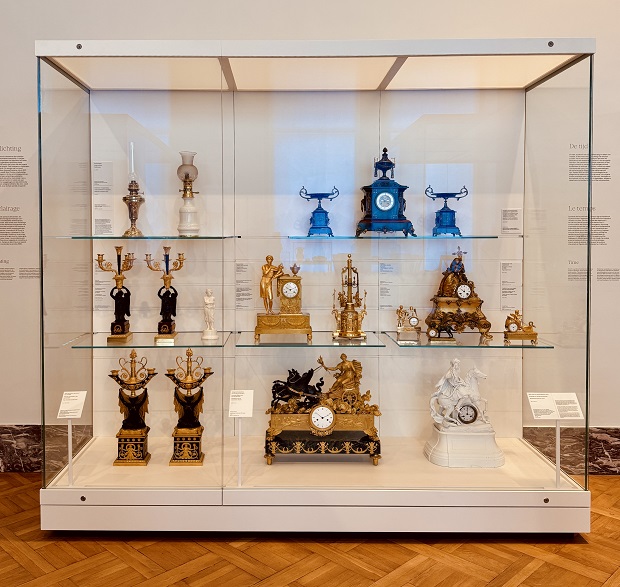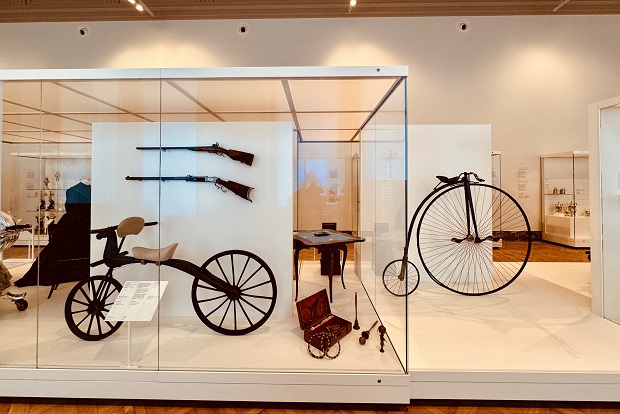- Daily & Weekly newsletters
- Buy & download The Bulletin
- Comment on our articles
Brussels’ Art & History Museum unveils Art Nouveau and Art Deco splendours
New galleries finally open to the public as a showcase of Belgium’s decorative arts heritage. The Cinquantenaire museum boasts two lofty airy spaces, one dedicated to 19th century movements, the other to Art Nouveau and Art Deco.
A treasure trove of exceptional artworks awaits visitors at the Museum of Art & History in Brussels. The new 1,200m² space consists of two galleries that recreate the style and splendour of life in the 19th century and the first half of the 20th century.

From gleaming wooden display cases filled with heritage pieces to recreated home settings of furniture and decor, the artistry and craftmanship of Belgian designers and artisans is stunning. The Pièce Montée studio from Gentbrugge is responsible for the discreet and effective scenography.
The first gallery opens with an immersion in Art Nouveau, which was founded in 1893 in the Belgian capital. A series of themes show off the richness and diversity of the artistic style, characterised by sinuous lines and floral motifs. The social and economic contexts of the movement are explored as well as the all-important network of relationships between patrons and artists.
All the familiar Art Nouveau names are present: Paul Hankar, Henry van de Velde, Victor Horta, Georges Hobé, Paul Hamesse, Léon Sneyers, Gustave Serrurier-Bovy, Isidore and Hélène De Rudder, Charles Van der Stappen and Philippe Wolfers.

As a centrepiece, Horta’s winter garden provides the wow factor with its rich detailing. Designed for the Cousin House in 1900, the steel structure with gilded features and warm wood panelling has been entirely restored and reassembled. Through stained glass doors and windows – complete with beautifully bevelled glass – visitors gain an extraordinary insight into the movement’s stylistic ethos as visioned by its pioneering master.

It was thanks to one of Horta’s students, architect Jean Delhaye, that the garden’s components were carefully dismantled in the 1960s. Their restoration and reassembly were led by the Horta specialists Barbara Van der Wee Architects.
Moving onwards in the gallery, Art Deco emerges as the dominant style of the 1920s and 1930s. The celebration of the centenary of the movement in Brussels in 2025 was one driving force for this project.

First emerging in Paris at the 1925 International Exhibition of Modern Decorative and Industrial Arts, Belgium played an important role in the salon’s international influence. Artists and designers such as Philippe Wolfers and Pieter Braecke made major creative contributions. The event was also key in reforming Belgium’s art and design education, resulting in the founding of La Cambre/Ter Kameren art school under the progressive leadership of Henry van de Velde.

This section devoted to the interwar design period – all geometric shapes, sleek lines and exotic motifs – reveals how it was inspired by classical references. Belgium’s leading designers and companies are on display, including Charles Catteau, Val-Saint-Lambert and the De Coene Brothers. At the end of the gallery, the magnificent bronze sculpture Hunting Diana by Marcel Wolfers stands regally.
The second space is filled with 19th century decorative arts; an amalgam of different periods and influences that show how society was rapidly changing. From urbanisation and the rise of the bourgeoisie to advances in science, technology and industrialisation, new styles emerged in the decorative arts.

At the beginning of the century, the neoclassical style was inspired by classical antiquity with French emperor Napoleon Bonaparte influencing a new aesthetic in furniture and luxurious objects.
The Restoration style heralded a lighter and more playful touch in the period of Charles X in France and William I in the United Kingdom of the Netherlands, which included present-day Belgium. Brussels porcelain was particularly prized. The Vonêche Crystal Factory was the precursor to Val-Saint-Lambert and Baccarat and produced exquisite luxury glassware.

Other styles ensued, including Gothic, Neo-Rococo and Neo-Renaissance. Neo-Gothic resonated with Catholics and influenced churches, schools, stations, post offices, castles and homes. Belgium was a leader in Europe for this eclectic style, which foreshadowed of course the emergence of Art Nouveau.
This section also provides enlightening and amusing touches. There ae fascinating insights into the art of dining, hygiene, outdoor leisure, travel, early childhood and play, lighting, timekeeping, fashion, photography and communication as well as applied arts.
Admission is free to the new galleries from 13 to 15 June.
Photos: ©BE Culture
















